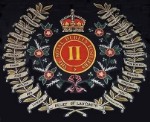Charles Daniels and John Hamilton, Ltd.
Charles Daniels was a publishing executive and reserve officer of the British Army who in 1925 founded the publishing firm, John Hamilton, Ltd. During the First World War, he served in France and afterwards lived in the United States for two years. The company was active until January 1940, when Daniels returned to the army. The Library of Congress catalog lists 90 books published by John Hamilton, Ltd. Claud Sykes was associated with Daniels' firm for twelve years as both an author and translator.
Charles Henry Daniels
Daniels was born in 1889 in Reading, a small industrial city about 60 kilometers west of London. His father, a Londoner, was an insurance agent. Daniels received his secondary education at the Kendrick Boys' School, an endowed grammar school in Reading. After leaving, he entered University College, Reading from which he received a diploma in letters in 1911. At the time, the school did not have a royal charter and could not award degrees; however, students who attended for three years could be examined for a degree by Oxford University. During his last university year, Daniels was a member of the Officer Training Corps and in April 1912, was commissioned a probationary reserve second-lieutenant in the 4th (Special Reserve) Battalion, Royal Inniskilling Fusiliers. Why he selected an Irish regiment is not known as vacancies were abundant in all regiments (the special reserve having only 697 of its authorized 1,915 lieutenants).
n/ Birth Registrations, Reading, 2nd quarter 1889; Household Return, Census of England and Wales, 1901; Who's Who in the British War Mission in the U.S.A, 2nd Ed. (New York: Edward J. Clode, 1918), s.v. "Daniels, Maj. Charles Henry;" Evening Standard, June 10, 1911; London Gazette, April 9, 1913; 11 H.L. Deb. (1912) 965-75.
The special reserve was successor to the militia under the Territorial and Reserve Forces Act, 1907. Pursuant to the statute, the War Office assigned each infantry regiment at least one territorial force battalion and one special reserve battalion. As there were no territorial force units in Ireland, each of the eight, Irish, line infantry regiments had at least two special reserve battalions. In the event of hostilities, the special reserve battalions would be replacement pools for their regiments' regular battalions in the war zone. Upon mobilization, they would also supply officers to the regular battalions to bring their officer complement to war strength
n/ 7 Edw. 7, c. 9; 11 H.L. Deb. (1912) 981-94.
Daniels received his initial, five-months' training with 2/Royal Inniskilling Fusiliers stationed at Aldershot Camp, Hampshire. He completed the course in September 1912, the War Office confirmed his commission, and he returned to civilian life. Daniels' employment from 1912 through 1914 was interrupted twice by reserve duty. The 4/Royal Inniskilling Fusiliers did their annual training at Finner Camp, Co. Donegal, in June 1913 and June 1914. For those years, the War Office had set the annual training period as 26 days. From September 1912 to August 1914, Daniels likely worked in the publishing or book-selling trade as after the First World War, he was employed by The Field Press, Ltd., a publisher.
n/ Folkestone Express, June 4, 1903; Broad Arrow, May 1, 1914.
At the outbreak of war in August 1914, 4/Royal Inniskilling Fusiliers was mobilized at Fort Dunree on Lough Swilly, Co. Donegal. In October, it moved 5 miles down the coast to Ludden Camp, Buncrana. Through the end of 1916, Daniels served twice in France with the 2/Royal Inniskilling Fusiliers, though he did not experience combat. In late 1915, Daniels married Mary Florence Clotworthy, daughter of a Hampshire schoolmaster. Mary, at the time of marriage, was a primary school teacher.
n/ Chris Baker, "Royal Inniskilling Fusiliers" on his WWI website The Long Long, Trail; Monthly Army List, various issues; Household Return, Census of England & Wales, 1911; Marriage Registrations, Kingston (Surrey), 3rd Quarter 1915.
In November 1917, Daniels, then a captain, was assigned to the British Military Mission to the United States with temporary rank of major. He was posted to newly built Camp Gordon north of Atlanta, Georgia where he was an advisor in gas defense. Camp Gordon was one of the US Army's largest facilities and could accommodate 41,000 soldiers.
n/ London Gazette, Suppl., February 8, 1918; Who's Who in the British War Mission in the U.S.A. (1918); Who's Who in the British War Mission in the U.S.A, 2nd Ed. (New York: Edward J. Clode, 1918), s.v. "Daniels, Maj. Charles Henry;" US Army Center of Military History, World War I Online Centennial Exhibit.
After released from war service, Daniels remained in the special reserve with the rank of captain. In July 1923, he resigned his commission and the War Office gave him the customary step-in-rank to major.
n/ Monthly Army List, various issues; London Gazette, February 8, 1918, July 3, 1923.
Medal Card of C.H. Daniels
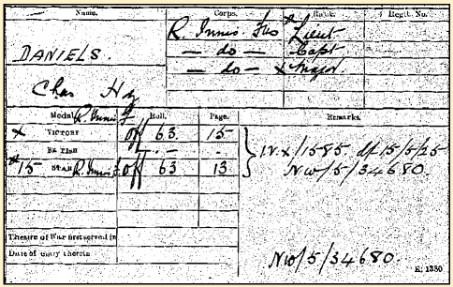
© Crown Copyright
After demobilization in 1919 or early 1920, Daniels was employed by The Field Press Limited, publishers of The Field, The Queen, and The Law Times. Since 1919, the company was controlled by the ship-owning Runciman family, and Sir Walter Runciman was its principal shareholder. Under the Runcimans, the Field Press established the literary journal The London Mercury. Its first editor was the noted poet, J.C. Squires and the London Mercury became an important literary publication of the inter-war years. In November 1920, The Field Press sent Daniels to New York as its representative in the United States and Canada. Charles and Mary Daniels resided in Manhattan until late 1922.
n/ Immigration Records, Ellis Island, November 14, 1920; Publishers' Weekly, May 7, 1921; London Mercury 4, no. 23 (September 1921); New York Herald, October 15, 1922; M.L. Biscotti, British Sporting Periodicals (London: Rowman & Littlefield, 2019), 24; Sheffield Independent, March 12, 1926.
In 1922, Brentano's, the American book publisher and retailer, hired Daniels to head its newly established UK subsidiary, Brentano's, Ltd. Brentano's was founded in New York in 1853 by an Austrian immigrant, August Brentano. That publisher's press release for its new London establishment states Daniels was "known to many of the publishing trade in America." Among the first books published by the London firm were Casanova's Homecoming (Arthur Schnitzler), Doctor Heraclius Gloss (Guy de Maupassant), The Doom Trail (Arthur Howden Smith), The Fool (Channing Pollock), Napoleon the First (Walter Geer), Psycho-Analysis and Love (Andre Tridon), Memories of a Shipwrecked World (Countess Kleinmichel), and Foster's Practical Poker (R.F. Foster).
n/ Publishers' Weekly, October 28, 1922; Advertisement, The Sphere, February 24, 1923.
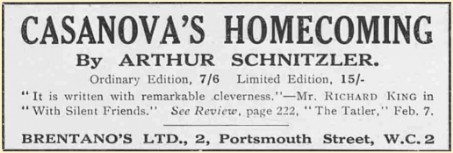
The Tatler, February 21, 1923.
Daniels left Brentano's in 1925 to form the company John Hamilton, Ltd. through which he was active as a publisher for fifteen years.
At the outbreak of the Second World War, the Daniels lived in Hersham, 25 kilometers southwest of central London. Charles signed up as an air raid warden. On January 5, 1940, after the UK had been at war for sixteen months, 51-year-old Daniels returned to the army as an administrative officer of the Royal Army Ordnance Corps. He received an emergency commission as a first-lieutenant and in July 1941, was promoted to temporary captain. In early 1944, the War Office placed Daniels on the "unemployed list" and shortly thereafter he returned to civilian life. He did not revive John Hamilton publishing.
n/ Register of England & Wales, 1939; Quarterly Army List, various years.
When Daniels left the army he was aged 55 and likely retired as he probably had made a small fortune from publishing. He may have; however, established another business using a pseudonym as he did with John Hamilton, Ltd.
In 1948, the Daniels were living in the village of Bovey Tracey (Devon), about 8 kilometers northwest of the Channel resort town of Torquay. The Daniels gained some notoriety when in January 1949, they found a woman's body on their lakefront property, Grey Walls. The inquest determined that the 48-year-old decedent, a London resident, had committed suicide by drinking a disinfectant.
Sometime afterwards, Charles and Mary Daniels moved out to the countryside, about 3 kilometers west of Bovey Tracey near the hamlet of Ilsington. Their house was, and remains, known as Greycot. Charles Daniels died in 1970 at age 81; Florence in 1988 at age 99.
n/ Western Times, January 28, 1949; Probate Register of England and Wales - 1971, 1989.
John Hamilton, Ltd.
Daniels capitalized the company in 1925 with £2,000. It's corporate registration stated it would be a publisher of newspapers, magazines, books and other literary works and undertakings as well as a printer, stationer, bookbinder, etc. The initial directors were C.H. Daniels and his wife, Mary Florence. The company's office was first located at 2 Portsmouth Street, London which is near Lincoln's Inn Fields in Holborn. That building housed many publishing offices including that of Brentano's, Ltd.
The company's first publications were part of a series known as "Sundial Editions" and Daniels chose a sundial as the company's colophon. This symbol was retained throughout the publication history of John Hamilton, Ltd. whose first book was released in 1925.
n/ John Krygier, "Vanguard Series" on the website A Series of Series, seriesofseries.owu.edu; Times Literary Supplement, September 17, 1925.

John Hamilton's earliest books presented an eclectic mix of mass market fiction and non-fiction. The titles and short descriptions indicate they would have appealed to the Ulysses character, Molly Bloom. Following are their offerings as shown in a half-page advertisement in The Bookman, December 1925.
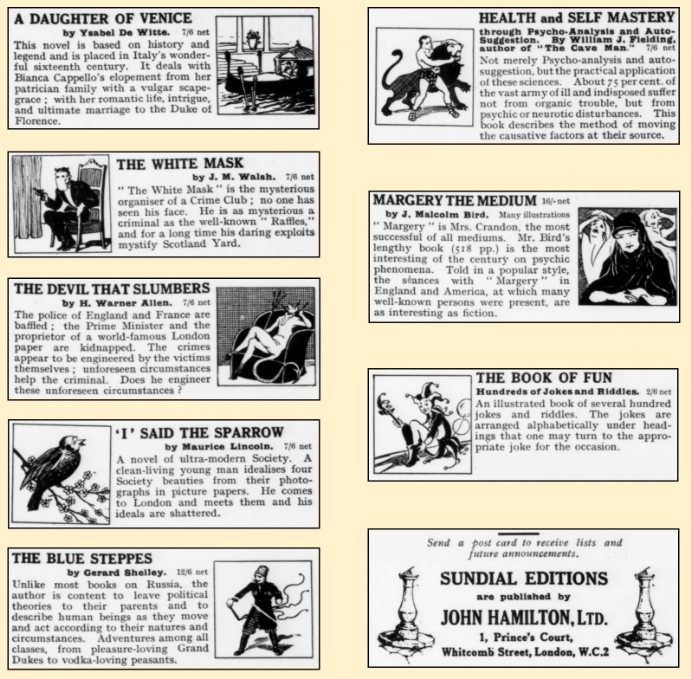
One year later, John Hamilton advertised the following books in the Times Literary Supplement, November 25, 1926. Their titles indicate that Daniels now targeted somewhat more sophisticated, lower-middle class readers. Leopold Bloom, Molly's husband, would have been interested in these books.

For the 1928 catalog, click here and it will open from this website in a new browser window. The file is a 14.9 MB pdf.
In the 1930s, Daniels entered the juvenile market with chauvinistic, civil and military aviation publications that often glorified the fading British Empire. He seems to have set out to corner such market as John Hamilton, Ltd. "published biographies of distinguished airmen, instructional books, war memoirs, histories of aviation, picture postcards of famous aeroplanes, and fine water-colour examples of aerial art, as well as over seventy different full-length flying stories." (Click here to view an advertisement for aviation prints which will open in a popup window.) By the mid-1930s, the company was known as a specialist publisher of books concerned in any way with aviation, as well as cookbooks and general fiction, especially thrillers.
n/ Dennis Butts, "Imperialists of the Air - Flying Stories 1900-1950" in Imperialism and Juvenile Literature, Jeffrey Richards, ed. (Manchester: Manchester Univ. Press, 1989); D. Kilham Roberts, ed., The Authors, Playwrights, & Composers Handbook for 1935, 194.
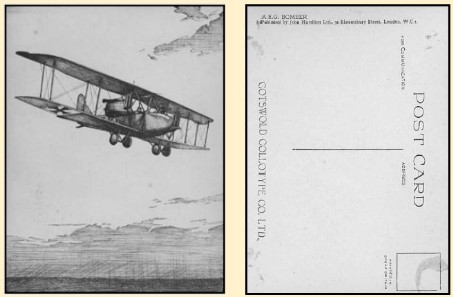
German A.E.G. Bomber Postcard, John Hamilton, Ltd.
Possibly the only time that Daniels' name appeared in a John Hamilton book was in 1936. That year, the company released an anthology titled The Cockpit and the cover page has "Edited by Major C. H. Daniels." Of the book's eight stories, four are shown as written by "Kenneth Quintrel." Quintrel is likely a pseudonym for Alfred Edgar, who later became a successful playwright. One story, "The English Offensive," is by the German WWI pilot, Rudolf Stark. As Sykes translated Stark's book, Wings of War, it's likely that he translated this short story.
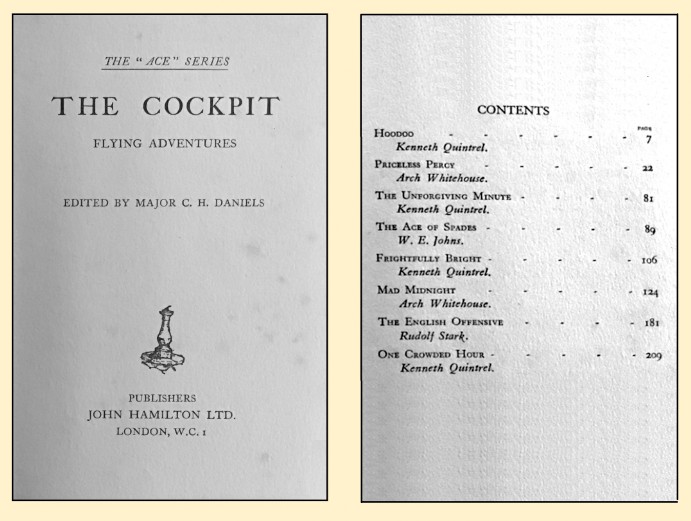
One of Daniels' most lucrative ventures was the magazine Popular Flying. Aimed at the general public, this monthly first appeared in March 1932 and two years later had a circulation of 24,500. The editor was W.E. Johns, writer of best-selling aviation fiction, primarily for the juvenile market. Johns is best-known as author of the "Biggles" series, the first five books of which were published by John Hamilton, Ltd. In 1935, Daniels sold Popular Flying to George Newnes, Ltd. then owned by Frank Newnes, the founder's son.
Popular Flying under Newnes
In the late 1930s, Johns became progressively more critical of the government's policy of appeasement towards Nazi Germany. The magazine's October 1938 issue contained an editorial on the recent Munich Peace Conference between Prime Minister Chamberlain and Chancellor Hitler. Johns wrote of Hitler: "Civilization was suddenly confronted by a new menace - an international gangster in a big way. That's all Hitler really is. Just an arch-gangster; a thug who points a machine gun at a crowd of men, women and children." Two months later, Johns wrote "For every blow that Hitler can strike, we must be able to strike two in return. This is the only argument dictators understand." Several politicians who supported Chamberlain then brought pressure on Frank Newnes to fire Johns. Newnes obliged in 1939 and the May issue of Popular Flying was the last one Johns edited. Newnes continued the magazine for two more issues then terminated its publication about one month before the UK declared war on Germany.
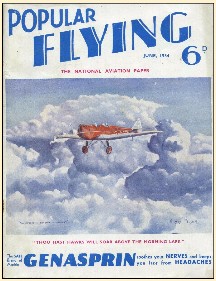
n/ "Captain W.E. Johns" on the website of The Twickenham Museum, www.twickenham-museum.org.uk; Roger Harris on his website Popular Flying Dot Com; Peter Berresford Ellis and Jennifer Schofield, By Jove, Biggles!, rev. ed. (London: Wright, 2003), 146.
Daniels, through his company, published another aviation magazine, Wings. Launched two years after the debut of Popular Flying, it lasted for only ten issues, the final one released in January 1936. Claud Sykes, under the name "Vigilant," had five articles published by Wings. He also had several translated articles published ("Claud W. Sykes" shown as translator). Unlike Popular Flying, Daniels edited this new magazine and wrote several editorials.
Wings, Vol. 1, No. 1 (Autumn 1934)
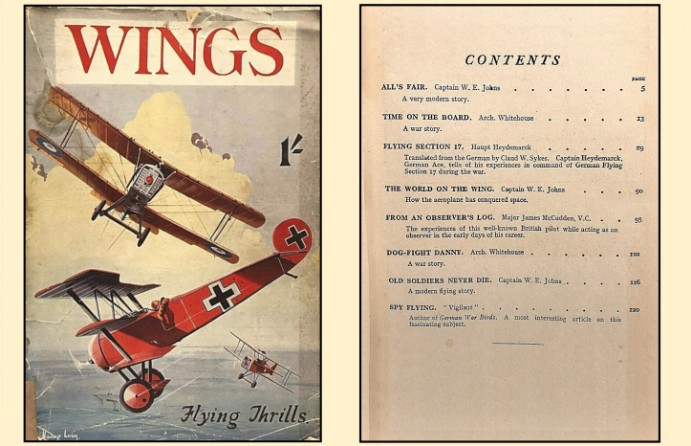
John Hamilton, Ltd. ceased operations in early 1940 when Daniels returned to the army. The last works it published were Mystery of the Tumbling V and Finland Breaks the Russian Chains. The former was by David T. Lindsay, a mystery writer whose 18 novels were all published by Daniels. The latter was written in German by Heinz Halter and translated by Claud Sykes. It's an account of German support and assistance given to the Finnish independence movement up to May 1918. Sykes was selected as translator on the recommendation of Karl Otten, on whom Sykes spied for MI-5.
Stella & Rose's Books, in the village of Tintern across the Severn from Bristol, has a large collection of books published by John Hamilton, Ltd. They're offered through a well-illustrated, online catalog. None of these books are reprints or facsimile editions. Click on the above link and that selection will open in a new browser window. Their website is configured for online purchases and they ship worldwide.
Click on the icon on the right for available titles by Claude Sykes as author or translator. That webpage will open in a popup window.
F.F. Simulations, Inc. and its affiliated persons are not connected in any manner with the above-mentioned vendor
and receive from them no monetary or other compensation.
[ You are at www.majortweedy.com>People>Sykes>John Hamilton, Ltd. ]
